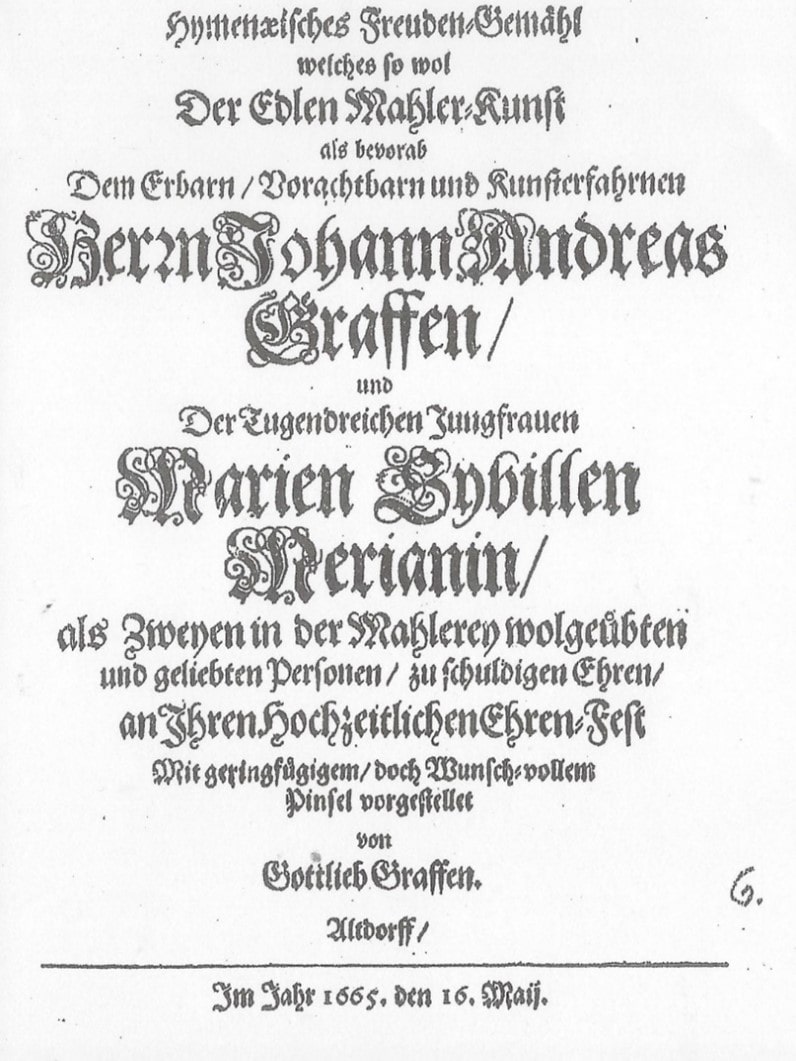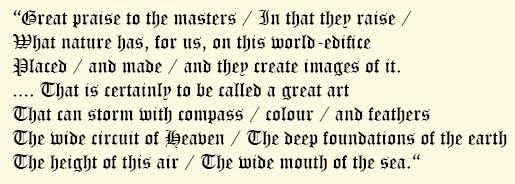POEMS BY GOTTLIEB GRAFF
Hymen's *) Portrait of Joy
which is to both
The Noble Art of Painting
as well as a Prelude
To the honourable / esteemed and
Master Johann Andreas Graff
Graffen /
and
The most virtuous Maiden
Maria Sybilla
Merian(in) **)
As two very experienced and
beloved Persons / in their
deserved Honour on their honourable Wedding Feast
With a modest / but wish-full
Brush presented
by
Gottlieb Graff.
Altdorff ***)
In the year 1665. May 16th. ****)
Transcription of the German Text
Hymenaeisches *) Freuden-Gemähl welches so wol Der Edlen Mahler-Kunst als bevorab Dem Erbarn Vorachtbarn und Kunsterfahrnen Herrn Johann Andreas Graffen
und Der Tugendreichen Jungfrauen Marien Sybillen Merianin **) als Zweyen in der Mahlerey wolgeübten und geliebten Personen zu schuldigen Ehren an Ihren Hochzeitlichen Ehren-Fest
Mit geringfügigem doch Wunschvollem Pinsel vorgestellet von Gottlieb Graffen.
Altdorff ***) Im Jahr 1665. den 16. Maij. ****)
*) Here synonym for “nuptial”, because Hymen was the Greek God of wedding.
**) Female endings on women’s names were common in German at that time.
***) The university town for Nuremberg in the latter’s own territories.
****) Reference: Ratsschulbibliothek Zwickau,
Shelfmark: 48.8.7.(6); MF 5628
Up to now (2023), only the title page has been digitised.
The Author and his Poems
While the other booklet contains nine pages of different poems by three authors, the "good patrons and uncoloured friends" (see separate analysis), this booklet comprises as many as fifteen pages of text and was created by a single author: Gottlieb Graff (1641-1708), the brother of Johann Andreas Graff and five years his junior. His elder brother must have been an important point of reference for him, because his father had died before his third birthday and his mother only five years later.
(1) At that time Gottlieb Graff lived in Altdorf, a small country town in Nuremberg territory, where the important university of this imperial city was developing successfully. After his studies there, Gottlieb Graff was a respected teacher in Nuremberg for decades. His eloquent poems on the occasion of his brother's wedding show his comprehensive education.
(2) With the heading on the title page, “Hymen’s Feast of Joy”, he has already chosen an unusual title, because the first word (an alternative for nuptial) refers to Hymen, the Greek god of marriage in antiquity; and with "portrait" he wants to show that he has composed his verses as if painting a picture with a brush.
(3) Gottlieb compares Frankfurt and Nuremberg and praises both of them. He calls Nuremberg – as was customary at the time – his brother's "fatherland" and praises the city of Frankfurt,
(4) He recalls the deceased, Graff’s parents as well as Merian’s father, and lets them take part joyfully from the world beyond.
(5) He is well acquainted with the history of painting and combines it with explanations about the meaning of the different colours.
(6) Gottlieb defends painting – at that time viewed as a mere "craft" – as "art".
The author probably adopted this view of art from his elder brother. It can certainly be assumed that Johann Andreas was a formative role model for his younger brother throughout his life. These laudatory poems therefore contain much useful information, as well as judgements that also correspond to the convictions held by Johann Andreas. In addition, they indirectly reflect how positively many more open-minded Nuremberg citizens rated the importance of fine artistic work and promoted it by means of commissions.
At that time travelling was expensive and arduous. Visits for family celebrations or educational trips (the "Grand Tour") could usually only be afforded by the wealthy upper class. The artisan Johann Andreas Graff had indeed travelled as far as Rome and had spent six years in Italy perfecting his skills as a painter and etcher, but such long "continuing education" abroad was unusual for the artisan class. In 1664, on his return to Frankfurt, he also came to Nuremberg and might already have told people about his plans to marry or might have written about them in his letters.
It is unlikely that Gottlieb himself was in Frankfurt for the wedding in May 1665. He probably sent his carefully phrased and printed verses instead.
Perhaps he did not meet his sister-in-law Maria Sibylla until three years after the wedding, when the young couple moved to Nuremberg with their first daughter Johanna Helena, who had been born shortly before.
In line with the thesis already explained in this text about the importance of art for both brothers, it is assumed here that Gottlieb's verses reflect the groom's ideal concept of a future and equal "sharing of roles" in his own marriage.
For the second part of his booklet of poems, Gottlieb invokes the Ancient Greek God Apollo with his chorus of Muses to sing the praises of the bride and groom: Johann Andreas and Maria Sibylla are kindly welcomed into the world of artists in many verses, such as:
The Muses bid farewell at the end of the booklet by hoping that the couple will be successful not only in Art, but also financially:
Interpretation: Margot Lölhöffel








